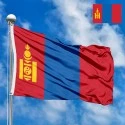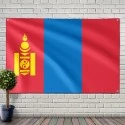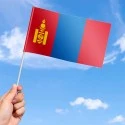The national flag of Mongolia is a powerful and iconic symbol that beautifully encapsulates the nation's rich history, profound cultural heritage, and enduring aspirations. Its design, steeped in tradition and symbolism, reflects the unique identity of this vast landlocked country, famed for its nomadic culture, expansive steppes, and the majestic Gobi Desert. Adopted in its current form in 1992, the flag tells a story of independence, spiritual wisdom, and the unbreakable spirit of the Mongolian people.
Design and Dimensions
The flag of Mongolia is a vertical triband composed of three equally sized stripes. The left and right stripes are a vibrant red, while the central stripe is a serene sky blue. A crucial element of the design is the national emblem, the Soyombo symbol, prominently displayed in yellow on the hoist (left) red stripe. The official proportions of the flag are typically 1:2 (height to width), giving it an elongated and distinctive appearance.
Symbolism of the Colors and Elements
Every hue and intricate element on the Mongolian flag is imbued with deep cultural and historical significance:
-
Red Vertical Stripes: The two red stripes flanking the flag represent eternal prosperity, freedom, and independence. Historically, this color also held connotations of revolution and socialism during the communist era. However, its modern interpretation strongly emphasizes the enduring spirit of liberty and the nation's aspiration for continuous well-being.
-
Blue Central Stripe: The central sky blue stripe symbolizes the eternal blue sky (Mongke Khukh Tengri), a revered concept in traditional Mongolian belief systems. It represents the nation's deep connection to nature, peace, and truth, reflecting the vast, open landscapes and the spiritual guidance believed to come from the heavens.
-
Soyombo Symbol (Yellow on Red): The Soyombo is not merely an emblem but a complex ideogram that embodies the essence of Mongolian nationhood, liberty, and sovereignty. Rendered in yellow, signifying eternity and prosperity, each component within it carries profound meaning:
-
Flame (top): Represents eternal growth, rebirth, wealth, and prosperity. Its three tongues symbolize the past, present, and future, or the three jewels of Buddhism (Buddha, Dharma, Sangha), reflecting Mongolia's rich spiritual traditions.
-
Sun and Moon (below flame): These celestial bodies are ancient symbols in Mongolian culture, signifying the eternity of the Mongolian nation. They express the aspiration that Mongolia will last forever, as long as the sun and moon shine.
-
Two Triangles (pointing down): Symbolize victory over enemies. Resembling downward-pointing arrows or spearheads, they indicate the readiness of the Mongolian people to defend their nation against any threats.
-
Two Horizontal Rectangles (center, above and below Yin-Yang): Represent honesty and justice, or "loyalty and justice." They symbolize the steadfast loyalty of the people to their country and the unwavering pursuit of justice in society, akin to straight, unyielding walls providing stability.
-
Yin-Yang (Taichi or 'Khas'): This symbol represents mutual complementarity, balance, and harmony between opposing forces. It signifies the peaceful coexistence of different elements, embodying the balance essential for societal well-being.
-
Two Vertical Rectangles (on either side of central elements): These symbolize fortress walls, representing the strength and unity of the Mongolian people. They convey the message that "unity is stronger than stone walls," underscoring the collective power protecting the nation.
History of Creation and Adoption
The Soyombo symbol itself boasts an ancient lineage, believed to have been created by the renowned Buddhist leader and polymath Zanabazar in the 17th century. It served as a national symbol long before the advent of the modern flag. The current flag design is a direct evolution from its socialist predecessor. The flag adopted in 1940 during the Mongolian People's Republic era also featured the red-blue-red triband and the Soyombo, but notably included a communist five-pointed star above the Soyombo.
The present flag was officially adopted on January 12, 1992, following the democratic revolution of 1990 and the promulgation of a new constitution. The removal of the communist star from the Soyombo in this updated design vividly symbolized Mongolia's transition to democracy, a market economy, and its renewed emphasis on traditional national identity.
Significance for the Inhabitants
For the people of Mongolia, their national flag is a source of profound pride, identity, and inspiration. It represents their unique cultural heritage, their unbroken line of independence, and their deep spiritual connection to their land and the "eternal blue sky." The flag embodies the resilience of a nation that has endured centuries of challenges, from the vast Mongol Empire to periods of foreign influence, always retaining its distinct spirit.
It fosters a strong sense of unity and patriotism, reminding citizens of their shared history, nomadic traditions, and Buddhist values. Displayed prominently during national holidays like Naadam (the traditional festival), public ceremonies, and in everyday life, the flag serves as a constant affirmation of Mongolian sovereignty and its commitment to a future built on peace, prosperity, and cultural preservation. It connects them to their ancestors and inspires future generations to uphold the nation's values.
Interesting Facts
-
Ancient Emblem, Modern Flag: The Soyombo symbol is one of the oldest continually used national emblems in the world, predating many modern national flags by centuries.
-
Zanabazar's Legacy: The Soyombo was created by Zanabazar, a revered figure in Mongolian history, renowned not only as a spiritual leader but also as a brilliant artist, sculptor, and architect.
-
Symbol of Post-Communist Transition: The modification of the Soyombo in 1992 (removing the communist star) powerfully marked Mongolia's shift from a socialist state to a democratic republic.
-
Connection to Nature: The blue stripe and elements of the Soyombo (sun, moon, flame) deeply reflect Mongolia's spiritual and cultural connection to the vast skies and natural elements of its homeland.
-
Geometric Harmony: Despite its complex symbolism, the flag's design is geometrically balanced, with the Soyombo itself being a carefully constructed set of symbols.
In the demonstration images, full-size flags are shown with proportions of 2:3, and hand-held flags with proportions of 1:2.







 Waving flag
Waving flag
 Sizes:
Sizes:
 Round flag
Round flag
 Sizes:
Sizes:
 Rectangular flag 2:3
Rectangular flag 2:3
 Sizes:
Sizes: